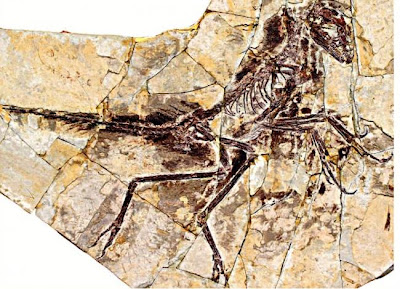Tuesday, January 29, 2013
Eosinopteryx: a ground-bound troodontid?
Welcome Eosinopteryx brevipenna to the gloriously fuzzy lineup of Chinese paravians!
Eosinopteryx is a new feathered dinosaur from the paleo treasure trove that is Liaoning Province, China. This tiny little fellow, sizing in at only around 30 cm long, was described as being a basal troodontid by the authors: it is extremely similar, skeletally, to Anchiornis, the fuzzy-footed woodpecker mimic famous for being the first dinosaur for whom a complete color study was performed. The fossil of Eosinopteryx, however, clearly lacks a feature for which Anchiornis is unique: it has no long feathers on the feet or ankles, and no tail feathers to speak of either.
It also appears to have rather blunt and short claws on the feet, whereas Anchiornis - tentatively assigned as a sister taxon to Eosinopteryx - had long and curved claws which appear to be the appropriate kind for climbing. Eosinopteryx is therefore considered to be a ground-running animal without the obvious adaptations for arboreality common to its brethren.
This has already been vehemently disputed in the paleo blogosphere, though. It's difficult to discount the possibility that legwings and tail feathers simply didn't preserve in the fossil, and that the animal would have had them in life. It has also been proposed that perhaps Eosinopteryx was a juvenile (most notably a juvenile Anchiornis), and the lack of defined legwings and retrices were a result of its youth and would have come in at adulthood. This is supported by its unusually large head and short snout, features commonly associated with juvenility in birds. However, the authors state that the animal is not a juvenile, as evidenced by closed sutures on the vertebrae - but then again, it has also been mentioned that closed sutures of this nature are sometimes found on animal embryos, so it may make no relevant difference.
In any case, the uncertain phylogenetic position of this pretty little paravian, as well as the general sentiment of "not convinced" by the paleontological community, leaves the importance of Eosinopteryx somewhat up in the air - a place the animal itself may or may not have been occupying.
Godefroit, P.; Demuynck, H.; Dyke, G.; Hu, D.; Escuillié, F. O.; Claeys, P. (2013). "Reduced plumage and flight ability of a new Jurassic paravian theropod from China". Nature Communications 4: 1394. doi:10.1038/ncomms2389.
Subscribe to:
Post Comments (Atom)



This is fantastic. I love how your subjects feel like real animals while also keeping a definite artistic style. Keep up the good work :)
ReplyDeleteGorgeous picture! And what an adorable little dinobirdy!
ReplyDeleteGood topic.
ReplyDeleteดูหนังไทย